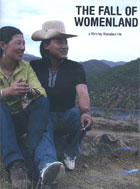
The Fall of Womenland 2009
Distributed by Cinema Guild, 115 West 30th Street, Suite 800, New York, NY 10001; 212-685-6242
Produced by Xiaodan He
Directed by Xiaodan He
DVD, color, 46 min.
Sr. High - Adult
Women's Studies
Date Entered: 06/04/2010
Reviewed by Nancy E. Frazier, Instructional Services Librarian, Bucknell UniversityThe Mosuo people live in mountainous southwest China, bordered by the Sichuan and Yunnan provinces. Their culture is unique in its practice of “walking marriage,” described in this film. Their small numbers—about 35,000 people—and their remote location have helped them preserve their matriarchal traditions for generations. Modernity and improved roads have increased tourism, and have enabled young Mosuo to come and go and explore the world around them. Their growing dependence on tourism has affected their traditions by eroding traditional cultural values. The Fall of Womenland explores Mosuo culture through following a young Mosuo woman named Bima.
The Mosuo’s tradition of “walking marriage,” encourages men and women to marry freely, as often as they wish. The couple meets after sunset at the woman’s home, with the man returning at dawn to his own mother’s home. Relationships are not bound by economic or family pressures, merely by the couple’s desire to be together. Children born from these unions are raised by the mother, in her mother’s home. Couples are free to separate when either the man or woman wants to move on. Bima’s lover visits her home at night, and they call or text each other often during the day. The growth of tourism and outsiders viewing “walking marriage” as freely available sex, have resulted in a red light district with young Mosuo prostitutes selling themselves to tourists.
The Mosuo “walking marriage” tradition outlived the aftermath of the Cultural Revolution and its Marriage Movement, which permitted only marriages between one man and one woman, and viewed Mosuo traditions as backward and primitive. During the Cultural Revolution, the communal Mosuo baths were segregated, with men and women no longer bathing together in their traditional manner. Following the Cultural Revolution, local traditions were allowed again, and many Mosuo returned to their inherited traditions.